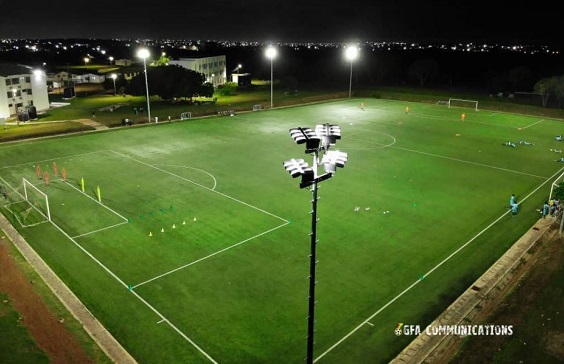The terrible state of road infrastructure, particularly key economic roads in the Bono Region, a hub of commercial agriculture and agribusiness, is gradually bringing socio-economic activities, to a standstill.
The lack of attention or total neglect of road networks in the region has rendered them deplorable with some portions serving as death traps to commuters.
The Bono Region has a total land size of 11,107 square kilometres, representing five per cent of Ghana’s territorial land, and has a 361,979 estimated farmer population made up of 183,885 males and 178,094 females.
The region with 12 municipal and district administrative areas is considered as one of the food baskets of the country, because almost all the districts are engaged in commercial agriculture.
However, the road network situation is dire in the region, because roads linking most of the communities, where foodstuffs are transported daily to the district and regional capitals are contending with bad roads.
With the exception of the Sunyani-Berekum-Dormaa Ahenkro Highway and Menji-Banda Road, which are in good condition, the rest of the road network across the region have become almost impassable and dangerous to travel on.
Notable among these key economic roads are the Sunyani-Chiraa-Techiman Highway, Berekum-Sampa, Buoku-Wenchi and Nkwanta-Kookumikrom roads.
Others are the Nsawkaw-Menji, Odomase-Seikwa-Nkwanta, Seikwa-Degedege-Nsawkaw and Sunyani-Atronie roads among other crucial roads.
Statistics available from the Bono Regional Department of Urban Roads indicate that there is a total stretch of 1,005 kilometres of urban roads in the region.
It consists of a total of 372 kilometres paved and 633 kilometres of unpaved roads.
Undoubtedly, road infrastructure plays a crucial role in the socio-economic development of any country, because the sector facilitates the free movement of people to transact business such as trading and transportation of goods and services.

State of the Bono Fire Service road
Not only that, poor road networks also negatively affect the health of citizens as well as revenue mobilisation, leading to the lack of development.
When the Daily Graphic visited some of the roads in the region, including town roads, they were bumpy, dusty and riddled with potholes.
Erosion had also eaten up parts, thereby making driving difficult and dangerous, with its attendant adverse effects on vehicles and on the health of commuters.
When it rains, parts of the roads get flooded, making it difficult to drive through and making it risky for commuters.
Most of the roads are considered economic roads because they are linked to the major districts and communities from where foodstuffs are transported daily to market centres.

Some frustrated farmers on the Buoku-Wenchi stretch expressing their displeasure with the poor nature of the road
The deplorable nature of the roads in the region is causing discomfort to the chiefs and people of the region, as they have to go through hectic journeys to transact businesses or seek medical attention.
The appalling nature of the road network has brought some socio-economic activities in the region to a near halt, as residents, particularly farmers, are unable to transport their produce to market centres.
Town roads
Some of the town roads in some of the major towns and district capitals, including Sunyani, the regional capital, have deplorable roads.
Checks by the Daily Graphic in the Sunyani Municipality revealed that some of the town roads, including those leading to institutions providing essential services such as the Ghana National Fire Service Regional Command are in bad state.
Others such as the Sunyani-Baakoniaba, St Mary’s School-Peace Junction and Penkwasi Traffic Light-Fiapre Roundabout roads as well as roads in the Central Business Area of Sunyani are also in poor state.
Additionally, the nine-kilometre Sunyani Technical University Roundabout-Fiapre Roundabout ring roads and the Alaska Junction-New Dormaa ring road constructed under the Sinohydro projects have started deteriorating after the project was abandoned some few months ago.
Portions of the ring roads have developed potholes, while erosion has eaten up part of the roads, especially around the U-drains, causing defect to the project.

Fatus Zaglaa, a Taxi driver, plying the Sunyani-Baakoniaba road, speaking to the ‘Daily Graphic’
Dormaahene
It was, therefore, not surprising that the President of the Bono Regional House of Chiefs (BRHC), Osagyefo Oseadeeyo Agyemang Badu II, on two separate occasions in June and August 2023, bemoaned the lack of good roads across the region.
The occasions were the grand durbar of a homecoming festival dubbed “Meko Bono” (I will go to Bono) held on Saturday, June 24 and the 2023 first general meeting of the house held on Thursday, August 17 in Sunyani.
He specifically mentioned the Sunyani town roads, Sunyani-Chiraa, Berekum-Sampa, Baakonieba-Berlin Top and Odomase roads as some of the roads in a deplorable state in the region.
Osagyefo Agyemang Badu, who is also the Omanhene of the Dormaa Traditional Area, said the region was far behind in terms of road infrastructure as compared to other areas in the country.
In February this year prior to the chief’s lamentations, the Bono regional communicators of the New Patriotic Party (NPP) boycotted all radio discussions in the region because of the deplorable condition of the roads, particularly the Kotokrom-Yawhima-Chiraa road.
The reason for the boycott was stated in a release signed by the chairman of the communicators, Asomah Salia, who asked the government to reshape the roads to spare them (communicators) the insults from residents.
The statement said residents along the road had been casting insinuations on the leadership of the party and ridiculing President Nana Addo Danwka Akufo-Addo, thereby making the government unpopular in the eyes of the people.

A portion of the Alaska Junction-New Dormaa ring road
Regional Minister
Responding to Osagyefo Agyemang Badu’s call during the meeting of the house of chiefs, the Bono Regional Minister, Justina Owusu-Banahene, pledged her commitment to push for the rehabilitation of the roads in the region.
She said she would do her best to visit the head offices of the Department of Urban Roads, Highways and Feeder Roads to change the narrative for the better.
Ms Owusu-Banahene said she had also taken notice of the poor state of the roads enumerated by the house and appealed to the chiefs to support her efforts.
Lamentations
A farmer at Suma Ahenkro, Samuel Appiah Danso, told the Daily Graphic that it was unfortunate that the region considered to be a food basket of the country roads had a bad road network.
A yam trader, Sophia Yemo, said the deplorable nature of the roads was discouraging traders from trading in the region because they found it difficult to transport foodstuffs they purchased from farm gates to major market centres.
Mrs Yemo, who travels on the Menji-Sunyani Road weekly, said drivers always used the deplorable state of the road to charge exorbitant fares.
She explained that the situation had resulted in the high cost of foodstuffs in markets across the country.
For his part, a driver, Fatus Zaglaa, popularly known as Work Hard, said driving on poor roads was negatively affecting the health of drivers and their vehicles.
He said the situation was killing the spirits of both farmers and drivers in the region and appealed to the government to act immediately to save the image of the region.
A retired nurse, John Atta Yeboah, said improving the current state of roads in the area could enhance the development of the region and reduce the high rate of poverty.
He said improving road infrastructure was important because it would provide access to markets, jobs, health, education and services.
The general consensus among citizens in Bono is that in a bid to save the region from being cut off from the rest of the country and sustain interest in agriculture and agribusiness, the government must put in place measures to immediately rehabilitate roads in the region.
Source: GraphicOnline






